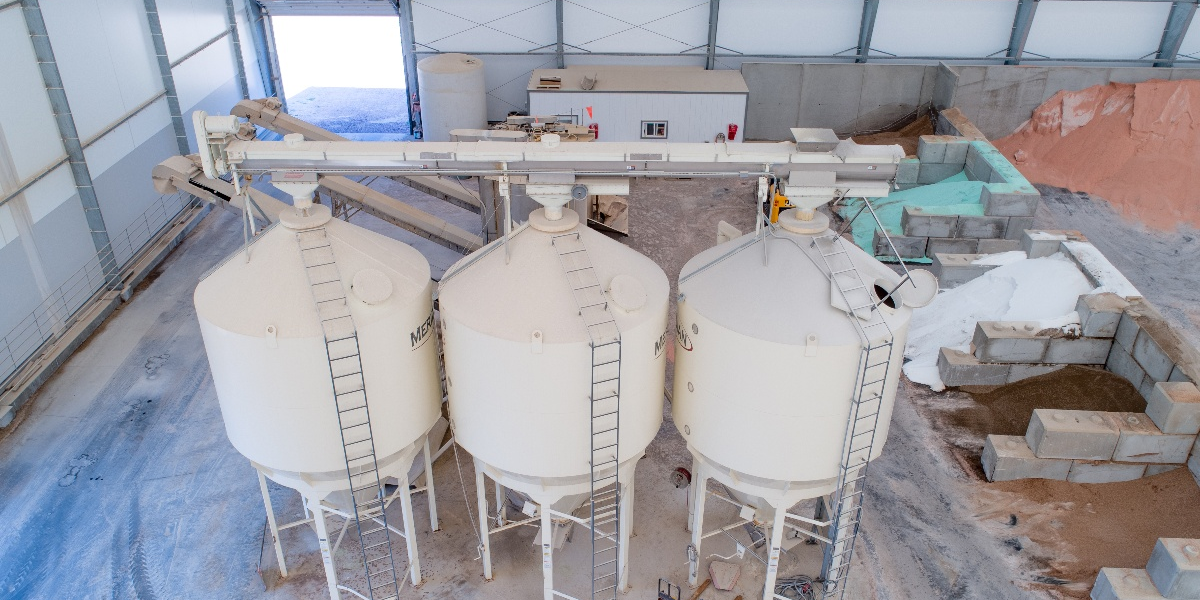Fertilizer Storage Building

Modern farming practices require using fertilizer to condition the soil. Storing and blending fertilizers and fertilizer chemicals such as urea, MAP, DAP, MEZ, ESN, nitrogen, phosphate, potash, sulfur, zinc and YaraVera requires specialty equipment and structures. Fabric structures are ideal for bulk fertilizer storage and blending facilities.
Why Fabric Structures for Dry Fertilizer Storage?
Dry fertilizer tends to coat everything in a fine dust – and depending on the chemical content of the fertilizer, this causes the structure to corrode. Steel buildings can be eaten by rust in just a few years, and even wooden fertilizer storage buildings are vulnerable to rust at the joists and fasteners.
Structural fabric, including Exxotec™ PVC fabric, has non-corrosive properties. For the ultimate in rust protection, a fabric interior liner seals the structure from the inside out – keeping the fertilizer away from the steel structure, and stopping corrosion before it even happens.
Large-scale fertilizer operations require abundant clear span space – including separated bays to store various types of fertilizer before mixing, as well as room for receiving, load-out, material handling and segregation. Combining lightweight architectural fabric with the proven strength of a solid steel frame allows building widths over 300 feet, along with any length.
Semi trucks, loaders, portable hoppers and other large equipment is further accommodated with wide portals and jack beams able to support any type of door for easy access, reclamation and transloading.
Watch a drone video tour of a flat storage building for fertilizer.
Fabric is a climate-responsive building material. Even before adding insulation, fabric structures hold the inside temperature rather than magnifying the outside conditions. This results in a building that is cooler on a hot day – lowering the risk of hot spots, and preventing condensation that will drip on stored fertilizer and cause clumping.
Fabric structures prevent nitrogen leaching and prevent groundwater contamination. Combining a protective fabric roof with a concrete foundation keeps stored fertilizer dry and contained, maintaining the quality of the fertilizer and protecting the surrounding area.
Benefits of Fabric Structures for Dry Fertilizer Blending
Fertilizer handing is a highly specialized practice. The Legacy team works with you to create a fabric fertilizer storage building designed to meet project specs.
Using a concrete foundation with stem wall increases storage capacity and maximizes the land available for construction. In most cases, equipment such as conveyors, cranes and conditioners can be mounted to the building frame for the most efficient operation when receiving and reclaiming granular or prilled fertilizer.
See some case studies of fabric buildings used for dry fertilizer storage.
“Using a fabric building for fertilizer storage is really the best long-term option,” said Paul Smith, Sales and Project Design Manager at Legacy Building Solutions. “Fabric buildings are typically installed sooner, they have the features the customer needs, and they don’t need maintenance. There are just a lot of advantages compared to other building types.”
A fertilizer blending facility engineered to meet customer needs provides immediate and long-term value for farmers co-ops, commercial fertilizer companies and elevators. Fabric structures protect your investment and simplify fertilizer storage and mixing operations.
See an example of a fertilizer blending building. Then contact us to get started on your dry fertilizer storage building.
